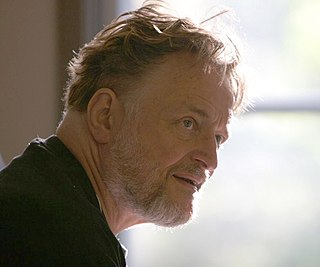Dance Dance Revolution (DDR) is a music video game series produced by Konami. Introduced in Japan in 1998 as part of the Bemani series, and released in North America and Europe in 1999, Dance Dance Revolution is the pioneering series of the rhythm and dance genre in video games. Players stand on a "dance platform" or stage and hit colored arrows laid out in a cross with their feet to musical and visual cues. Players are judged by how well they time their dance to the patterns presented to them and are allowed to choose more music to play to if they receive a passing score.

John Horton Conway was an English mathematician active in the theory of finite groups, knot theory, number theory, combinatorial game theory and coding theory. He also made contributions to many branches of recreational mathematics, most notably the invention of the cellular automaton called the Game of Life.

The sawtooth wave is a kind of non-sinusoidal waveform. It is so named based on its resemblance to the teeth of a plain-toothed saw with a zero rake angle. A single sawtooth, or an intermittently triggered sawtooth, is called a ramp waveform.
2 (two) is a number, numeral and digit. It is the natural number following 1 and preceding 3. It is the smallest and only even prime number.
20 is the natural number following 19 and preceding 21.
666 is the natural number following 665 and preceding 667.
TI-BASIC is the official name of a BASIC-like language built into Texas Instruments (TI)'s graphing calculators. TI-BASIC is a language family of three different and incompatible versions, released on different products:

iWork is an office suite of applications created by Apple for its macOS, iPadOS, and iOS operating systems, and also available cross-platform through the iCloud website.
224 is the natural number following 223 and preceding 225.
Todd G. Buchholz is an American economist, author, inventor, and business consultant. He served as Director of Economic Policy under George H. W. Bush and as managing director of Tiger Management. Buchholz regularly contributes commentaries on political economy, financial markets, business and culture to media outlets such as The New York Times, The Wall Street Journal, and The Washington Post, as well as major television networks.
WikiNodes is an app for the Apple iPad built by IDEA.org. WikiNodes was the first tablet app for browsing Wikipedia using a radial tree approach to visualize how articles and subsections of articles are interrelated. The app displays related items, which spread on the screen, as a spiderweb of icons.

The iPad is a brand of iOS and iPadOS-based tablet computers that are developed by Apple, first introduced on January 27, 2010. The iPad range consists of the original iPad lineup and the flagship products iPad Mini, iPad Air, and iPad Pro.
SpicyNodes was a system for displaying hierarchical data, in which a focus node displays detailed information, and the surrounding nodes represent related information, with a layout based on radial maps. It has web (Flash) and mobile (iOS) implementations. It has ended operation as of 1 January 2018.

Word Lens was an augmented reality translation application from Quest Visual. Word Lens used the built-in cameras on smartphones and similar devices to quickly scan and identify foreign text, and then translated and displayed the words in another language on the device's display. The words were displayed in the original context on the original background, and the translation was performed in real-time without a connection to the internet. For example, using the viewfinder of a camera to show a shop sign on a smartphone's display would result in a real-time image of the shop sign being displayed, but the words shown on the sign would be the translated words instead of the original foreign words.
Dart is a programming language designed by Lars Bak and Kasper Lund and developed by Google. It can be used to develop web and mobile apps as well as server and desktop applications.

The iPad is a tablet computer, developed and marketed by Apple Inc. It is the third device in the iPad line of tablets. It added a Retina Display, the new Apple A5X chip with a quad-core graphics processor, a 5-megapixel camera, HD 1080p video recording, voice dictation, and support for LTE networks in North America. It shipped with iOS 5, which provides a platform for audio-visual media, including electronic books, periodicals, films, music, computer games, presentations and web browsing.

Alexander Bellos is a British writer, broadcaster and mathematics communicator. He is the author of books about Brazil and mathematics, as well as having a column in The Guardian newspaper.
The iPad Mini is a line of small tablet computers designed, developed, and marketed by Apple Inc. It is a sub-series of the iPad line of tablets, with screen sizes of 7.9 inches and 8.3 inches. The first-generation iPad Mini was announced on October 23, 2012, and was released on November 2, 2012, in nearly all of Apple's markets. It featured similar internal specifications to the iPad 2, including its display resolution.
"Cheryl's Birthday" is a logic puzzle, specifically a knowledge puzzle. The objective is to determine the birthday of a girl named Cheryl using a handful of clues given to her friends Albert and Bernard. Written by Dr Joseph Yeo Boon Wooi of Singapore's National Institute of Education, the question was posed as part of the Singapore and Asian Schools Math Olympiad (SASMO) in 2015, and was first posted online by Singapore television presenter Kenneth Kong. It went viral in a matter of days and also hit national television in all major cities globally. Henry Ong, the Founder of SASMO was interviewed by Singapore's Mediacorp program FIVE hosts Chua En Lai and Yasmine Yonkers.

macOS Monterey is the eighteenth major release of macOS, Apple's desktop operating system for Macintosh computers. The successor to macOS Big Sur, it was announced at WWDC 2021 on June 7, 2021, and released on October 25, 2021. macOS Monterey was succeeded by macOS Ventura, which was released on October 24, 2022.







